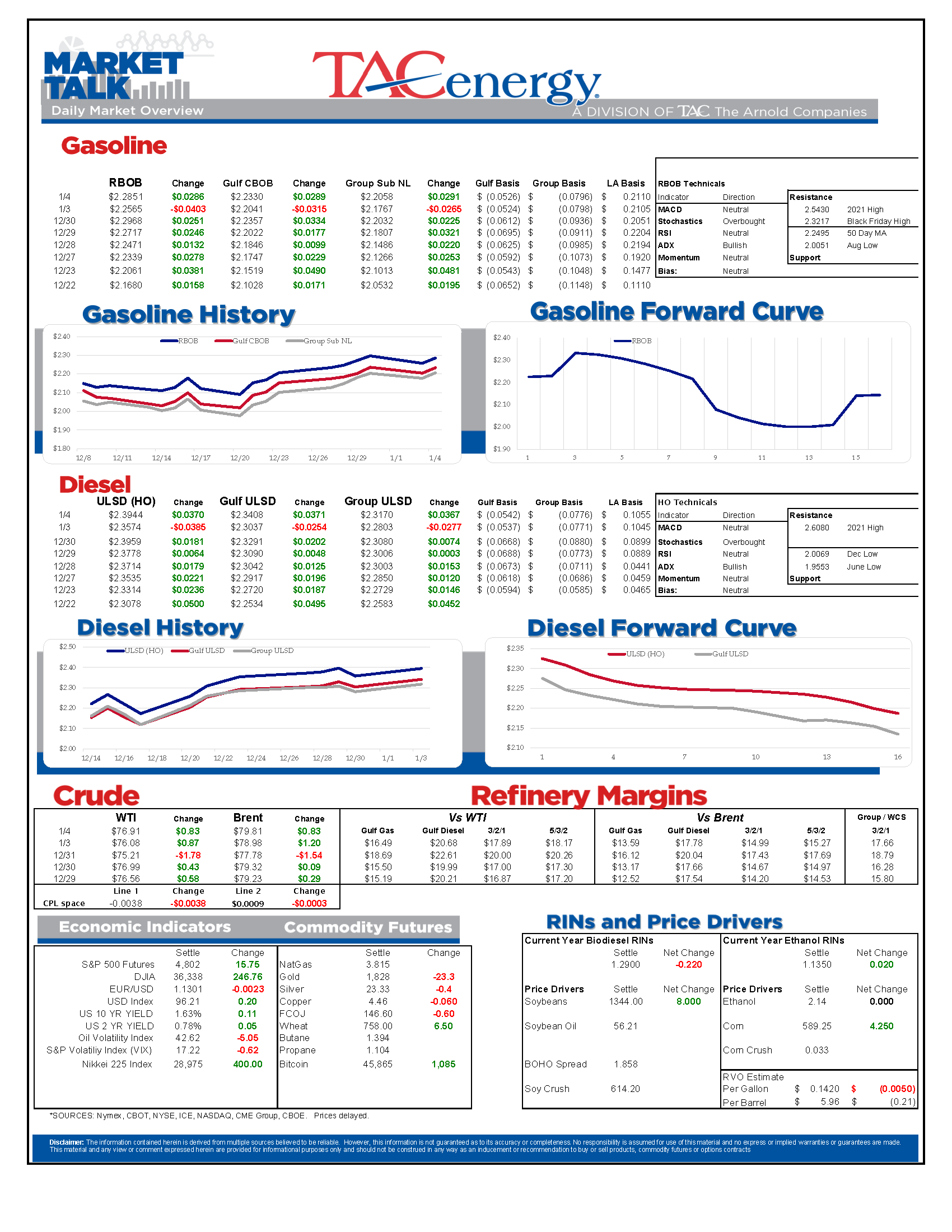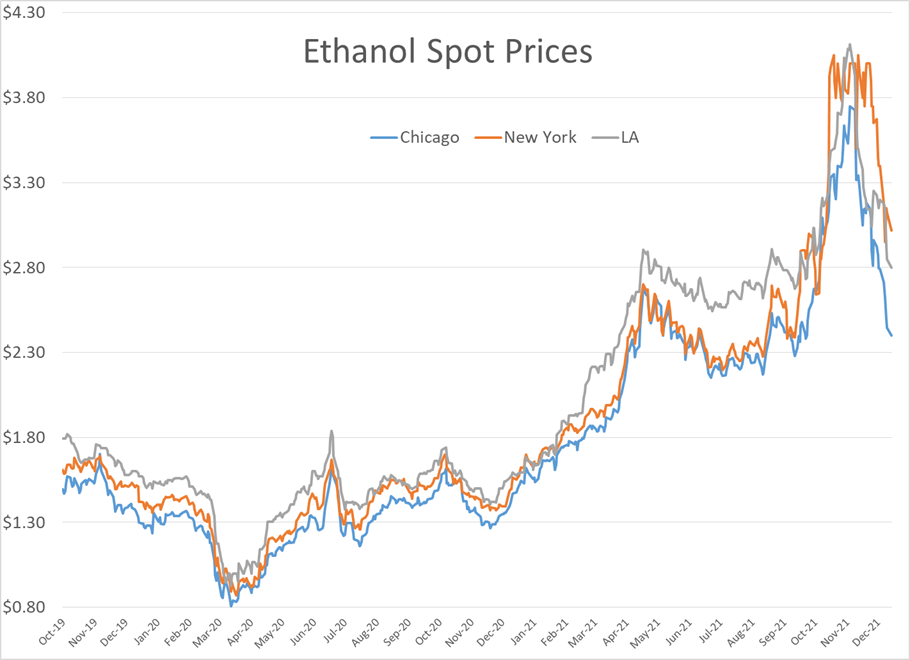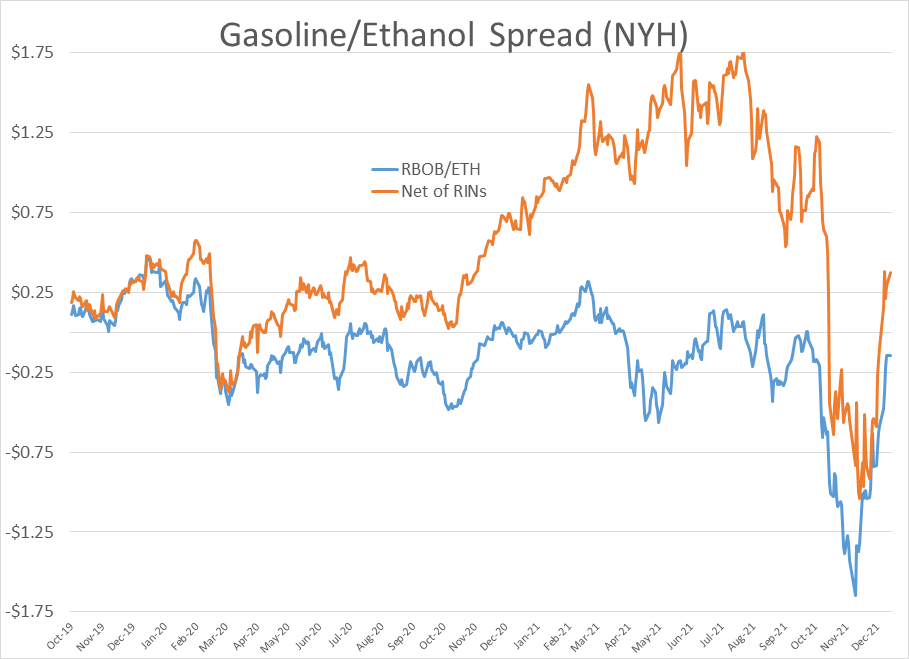A Healthy 2 Day Rally In Petroleum Futures Has Wiped Out The Heavy Losses Seen On New Year's Eve

A healthy 2 day rally in petroleum futures has wiped out the heavy losses you may or may not have seen on New Year’s eve. US stock markets are also pointing to fresh record highs as optimism about the overwhelming Omicron looks to be taking control.
Now that the downward sloping trend lines that pushed prices lower for 2 months were broken in the last 2 weeks of December, the charts for ULSD prices are looking bullish, with a test of the $2.40 range looking pivotal this week. Already this morning we saw an early run stall out at $2.3968, and $2.4059 marked the high set just before the Black Friday meltdown, so this resistance may not be easily broken, but if it is, the charts suggest we’ll see a run to $2.50 or higher in short order.
The RBOB charts aren’t quite as bullish as ULSD, but have a similar setup now that the bearish trend-line that saw prices drop 65 cents in 7 weeks has been wiped out. $2.30 looks to be the pivotal level for RBOB, with a break here opening the door for a counter-seasonal rally during the weakest fundamental time of the year.
Refinery hiccups continue to lend support to futures and cash prices, with 2 more gulf coast facilities taking FCC units offline over the past few days, adding to the setback from the 2nd largest plant in the country reducing rates after a fire two weeks ago. While the winter demand doldrums make it unlikely that we’ll see widespread gasoline shortages from this rash of issues, it is another reminder (or, if you prefer, warning) that the supply network is stretched more than it’s been in decades after numerous plant closures in the past 2 years, meaning there’s less cushion for the supply chain to absorb this type of disruption.
Ethanol prices are continuing their return to earth so far this week, with Chicago spots reaching a 2 month low around $2.40/gallon, about $1.35/gallon less than what they were going for at Thanksgiving. New York and LA values still command hefty premiums to the Chicago hub as logistical bottlenecks with railcars and trucks remain, but both are trading more than $1/gallon below where they topped out about a month ago.
RIN values meanwhile have had diverging paths depending on the contracts. After the D4/D6 spread blew out to a record north of 60 cents/gallon in the wake of the EPA’s new RVO suggestions, the gap between bio and ethanol RINs has shrunk dramatically in the past 10 days. Adding to that, there was 20+ cents of backwardation between 2021 and 2022 values for D4s, which has caused a big drop in current year values now that the calendar has flipped.
Click here to download a PDF of today's TACenergy Market Talk.
Latest Posts
Week 16 - US DOE Inventory Recap
Energy Markets Trading Quietly In The Red As Ethanol Prices Rally To Five-Month High
The Struggle For Renewable Producers Continues As A Rapid Influx Of Supply And Crashing Credit Prices Make Biodiesel
After Years Of Backwardation, Diesel Prices Have Slipped Into Contango Over The Past Week
Social Media
News & Views
View All
Week 16 - US DOE Inventory Recap

Energy Markets Trading Quietly In The Red As Ethanol Prices Rally To Five-Month High
Energy markets are trading quietly in the red to start Wednesday’s session after a healthy bounce Tuesday afternoon suggested the Israel-Iran-linked liquidation had finally run its course.
There are reports of more Ukrainian strikes on Russian energy assets overnight, but the sources are sketchy so far, and the market doesn’t seem to be reacting as if this is legitimate news.
Ethanol prices have rallied to a 5-month high this week as corn and other grain prices have rallied after the latest crop progress update highlighted risks to farmers this year, lower grain export expectations from Ukraine, and the approval of E15 blends this summer despite the fact it pollutes more. The rally in grain and renewables prices has also helped RIN values find a bid after it looked like they were about to test their 4-year lows last week.
The API reported small changes in refined product inventories last week, with gasoline stocks down about 600,000, while distillates were up 724,000. Crude oil inventories increased by 3.2 million barrels according to the industry-group estimates. The DOE’s weekly report is due out at its normal time this morning.
Total reported another upset at its Port Arthur refinery that’s been a frequent flier on the TCEQ alerts since the January deep freeze knocked it offline and damaged multiple operating units. This latest upset seems minor as the un-named unit impacted was returned to normal operations in under an hour. Gulf Coast basis markets have shrugged off most reports of refinery upsets this year as the region remains well supplied, and it’s unlikely we’ll see any impact from this news.
California conversely reacted in a big way to reports of an upset at Chevron’s El Segundo refinery outside of LA, with CARBOB basis values jumping by more than a dime. Energy News Today continued to show its value by reporting the upset before the flaring notice was even reported to area regulators, proving once again it’s ahead of the curve on refinery-related events. Another industry news outlet meanwhile struggled just to remember where the country’s largest diesel seller is located.
Click here to download a PDF of today's TACenergy Market Talk

The Struggle For Renewable Producers Continues As A Rapid Influx Of Supply And Crashing Credit Prices Make Biodiesel
The sigh of relief selloff continues in energy markets Tuesday morning, with gasoline prices now down more than 20 cents in 7 sessions, while diesel prices have dropped 26 cents in the past 12. Crude oil prices are within a few pennies of reaching a 1 month low as a lack of headlines from the world’s hot spots allows some reflection into the state of the world’s spare capacity for both oil and refined products.
Gasoline prices are trading near a 6-week low this morning, but still need to fall about another nickel in order to break the weekly trendline that pushed prices steadily higher since December. If that trend breaks, it will be safer to say that we saw the end of the spring gasoline rally on April 12th for the 2nd year in a row. Last year RBOB futures peaked on April 12 at $2.8943 and bottomed out on May 4th at $2.2500. The high (at this point) for this year was set on April 12th at $2.8516, and the low overnight was $2.6454.
It’s not just energy commodities that are seeing an unwind of the “flight to safety” trade: Gold prices had their biggest selloff in 2 years Monday and continue to point lower today. Just how much money poured into commodities in the weeks leading up to the direct confrontation between Israel and Iran is unclear, but we have seen in year’s past that these unwind-events can create a snowball effect as traders can be forced to sell to cover their margin calls.
Supply > Demand: The EIA this morning highlighted the record setting demand for natural gas in the US last year, which was not nearly enough to offset the glut of supply that forced prices to a record low in February. A shortage of natural gas in Europe was a key driver of the chaotic markets that smashed just about every record in 2022, and an excess of natural gas supply in Europe and the US this year is acting as a buffer, particularly on diesel prices.
The struggle for renewable producers continues as a rapid influx of supply and crashing credit prices make Biodiesel, RD and SAF unprofitable for many. In addition to the plant closures announced in the past 6 months, Vertex Energy reported Monday it’s operating its Renewable Diesel facility in Mobile AL at just 50% of capacity in Q1. The truly scary part for many is that the $1/gallon Blender's tax credit ends this year and is being replaced by the “Clean” Fuel production credit that forces producers to prove their emissions reductions in order to qualify for an increased subsidy. It’s impossible to say at this point how much the net reduction will be for domestic producers, but importers will get nothing, and at current CI values, many biodiesel producers may see their “blend credit” cut by more than half.
Click here to download a PDF of today's TACenergy Market Talk.



